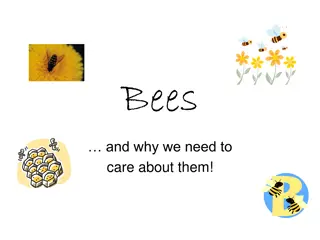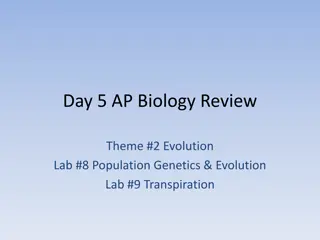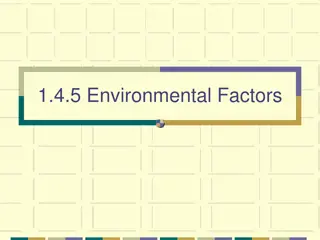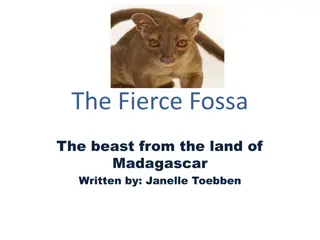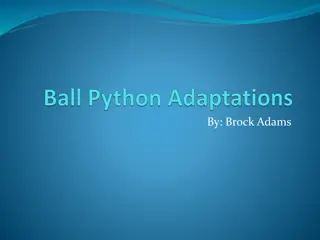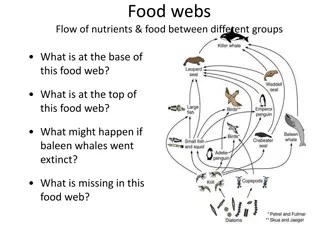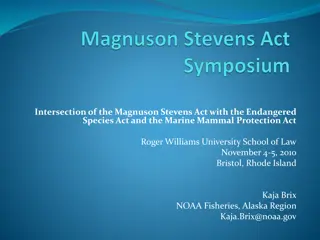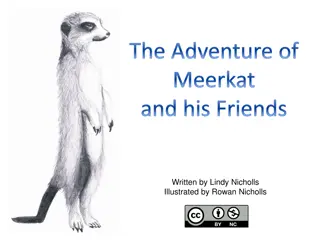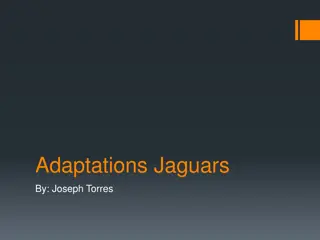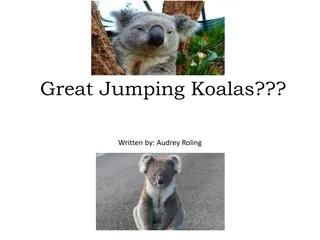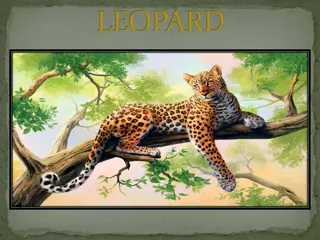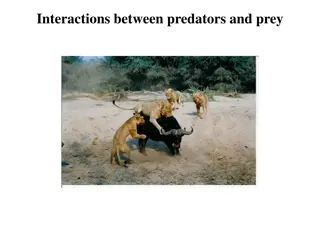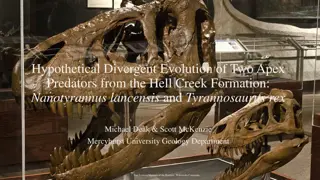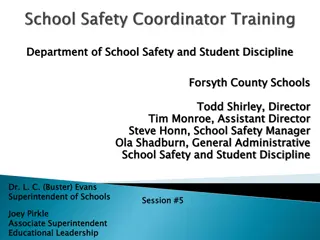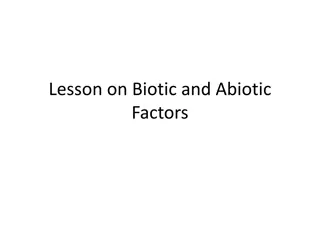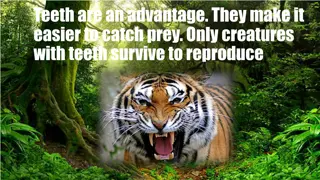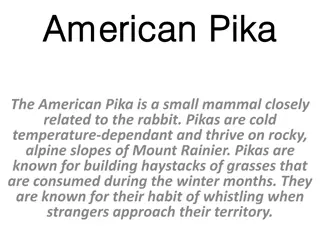Understanding Animal Camouflage and its Importance in Survival
Animal camouflage plays a crucial role in survival by allowing prey to blend in with their habitats to avoid predators, and enabling predators to effectively hunt for food. This natural adaptation enhances the chances of both prey and predators in the wild.
3 views • 46 slides
Fascinating Insights into Hammerhead Sharks
Hammerhead sharks, known for their unique hammer-shaped heads, are carnivorous creatures that primarily feed on fish, stingrays, and other sharks. They are swift swimmers, capable of outpacing many other shark species. These creatures inhabit various seas worldwide and have interesting interactions
0 views • 6 slides
Insights into the Deadly Yellow Spotted Lizard
Delve into the mysterious world of the Yellow Spotted Lizard, a venomous creature known for its lethal defense mechanisms. From its appearance to habitat, learn about predators, and understand why encountering this lizard is a risky affair. Uncover the unique features of this reptile as you explore
0 views • 29 slides
Importance of Bees: Why We Need to Care About Them
Bees are essential pollinators, with various species playing crucial roles in ecosystems. They forage for pollen and nectar, create honey, and live in diverse habitats. Bumble bees, honey bees, and solitary bees each have unique characteristics and contribute to biodiversity. However, bees face thre
6 views • 21 slides
Understanding Child Grooming: Recognizing and Preventing Abuse
Child grooming is a manipulative process used by predators to gain a child's trust and prepare them for sexual abuse. Predators often create multiple identities to appear positive to young people. It is crucial to be cautious online, report any suspected grooming, and seek help from trusted adults o
1 views • 4 slides
Exploring Evolution and Population Genetics in AP Biology
Delve into the fascinating world of evolution and population genetics with themes covering natural selection, genetic equilibrium, allele frequencies, and more. Understand how molecular and cellular events shape emergent properties at individual and population levels. Explore the impact of factors l
0 views • 12 slides
Surviving the Wild: A Fish's Journey Full of Challenges
Enter the wild as a fish, facing various obstacles such as parasites, predators, and human interference. Roll the dice and navigate through different scenarios where your fate hangs on the outcome. Learn interesting fish facts along the way as you strive to survive for a full year in the unpredictab
1 views • 20 slides
Online Safety and Social Media Guidelines for Students
Langford Middle School Classroom Guidance session in February 2020 focused on Internet safety and responsible use of Social Media. Students were encouraged to watch a video and engage in discussions on being safe online. Key topics included online interactions, identifying predators, and protecting
0 views • 16 slides
Understanding Environmental Factors in Terrestrial and Aquatic Environments
Environmental factors play a crucial role in shaping ecosystems. In both terrestrial (land) and aquatic (water) environments, organisms are influenced by abiotic factors such as temperature, light intensity, and pH, as well as biotic factors like plants, predators, and competitors. Understanding the
4 views • 19 slides
Discover the Fascinating World of the Fierce Fossa
Delve into the realm of the Fierce Fossa from Madagascar through this insightful report by Janelle Toebben. Learn about its appearance, behaviors, sounds, predators, and survival strategies. Explore the nocturnal habits, unique features, and challenges faced by this intriguing mammal.
0 views • 14 slides
Understanding Ball Pythons: Fascinating Facts and Behaviors
Ball pythons, known for their heat pits and night vision, have fascinating adaptations for hunting and survival in the wild. They use camouflage to hide from predators, roll into a ball when scared, and have unique eye placement for 360-degree vision. These snakes thrive in savannah and thorn scrub
2 views • 8 slides
Sustainable Practices for Protecting Earthworms in Vermiculture Beds
Implementing preventive measures like covering the vermibed with wire mesh, gunny bags, etc., and using neem-based insecticides can safeguard earthworms from predators like birds, ants, rats, and diseases. Following agricultural practices and maintaining favorable environmental conditions are crucia
0 views • 5 slides
Learn about the Dingo: The Beast of the Ground by Lucas Hayes McMahan
Discover the fascinating world of the Dingo in its natural habitat. This report covers their physical characteristics, diet, predators, survival adaptations, and more. From their unique appearance to hunting techniques and protective behaviors, explore the intriguing life of the Dingo.
0 views • 10 slides
Understanding Food Webs and Trophic Levels in Ecosystems
Food webs illustrate the flow of nutrients and energy between different organisms in an ecosystem. At the base of a food web are the primary producers, while predators occupy the top. If baleen whales were to go extinct, it could disrupt the balance of their ecosystem. Biomass decreases as energy is
0 views • 11 slides
Ecosystem Considerations in Fisheries Management Laws
Analysis of the intersection of the Magnuson Stevens Act, Endangered Species Act, and Marine Mammal Protection Act in addressing ecosystem considerations within fisheries management. Evaluation of current regulatory frameworks and the need for an ecosystem-based approach towards fisheries and apex p
0 views • 15 slides
Fascinating World of Squirrels: Facts and Insights
Squirrels, with their diverse species and habitats, play a vital role in ecosystems. They are omnivores, living in trees, underground burrows, or old logs. Predators like wolves and humans threaten them, but their agility helps in survival. Discover more about these charming rodents and their intera
0 views • 13 slides
The Adventure of Meerkat and His Friends
Meerkat, feeling lonely in his large clan, decides to embark on an adventure with his friends Ground Squirrel and Mongoose. As they journey through the African desert, they face challenges like avoiding predators and finding shelter. Will they succeed in their quest for a new adventure? Join them in
0 views • 12 slides
Fascinating Facts about Jaguars
Jaguars are powerful predators with a diverse diet, inhabiting a range of habitats from South America to Arizona. Their distinctive characteristics make them a remarkable species with various adaptations for survival.
0 views • 6 slides
Discovering the Fascinating World of Jumping Koalas
Join us on an exciting journey to uncover the hidden secrets of jumping koalas. From their unique appearance to their survival tactics, this report delves into every aspect of these adorable creatures, making them your new favorite animal. Learn about their physical characteristics, movements, diet,
4 views • 10 slides
The Fascinating World of Leopards
Leopards, with their well-camouflaged fur and adaptable nature, thrive in the wild. They are solitary predators known for their opportunistic hunting behavior, broad diet, and ability to move heavy prey into trees. Unlike lions, leopards do not live in groups, and adult males live separately from fe
0 views • 8 slides
Fascinating World of Penguins
Explore the diverse habitats, unique characteristics, and survival strategies of penguins, from the majestic Emperor penguins in Antarctica to the adorable Little Blue penguins in Australia. Discover how they stay warm, why they are black, and the predators they face in the wild. Dive into the capti
0 views • 12 slides
Fascinating Facts about Basking Sharks
The basking shark, second largest fish globally, is a filter feeder known for feeding near the surface. They prefer habitats with high zooplankton concentrations and are active year-round. Satellite tagging revealed their migratory patterns and social behaviors. Despite few predators, they are fasci
0 views • 12 slides
Understanding Predator-Prey Interactions: Impacts and Equilibria
Explore the dynamics of predator-prey interactions, including what defines a predator, the impacts predators have on prey populations, and the equilibrium points in the Lotka-Volterra Predator-Prey model. Discover how predation plays a crucial role in regulating population densities and observe the
0 views • 36 slides
Test Your Knowledge with Food Web and Food Chains Quiz
Explore the fascinating world of food chains and webs through this interactive quiz. Test your understanding of consumers, producers, predators, prey, herbivores, carnivores, and more. Challenge yourself to identify different roles in ecosystems and how organisms depend on each other for survival.
0 views • 22 slides
Interactions Among Living Things and Adaptations in Nature
Understanding the interactions among living things, such as competition, predation, and symbiosis, sheds light on how organisms adapt to their environments through natural selection. Each organism occupies a unique niche, defining its role in the ecosystem. Predation plays a crucial role in populati
0 views • 14 slides
Understanding Co-evolution: A Closer Look at the Red Queen Hypothesis in Biology
Co-evolution refers to the reciprocal genetic changes in species in response to each other. The Red Queen Hypothesis, illustrated in the arms race between parasites and hosts, exemplifies this phenomenon. This interaction drives evolutionary dynamics in herbivores, plants, pollinators, prey, predato
0 views • 18 slides
Considerations for Bringing Back Native Birds in Nelson
Before embarking on trapping activities to support native bird populations in Nelson, it is essential to assess existing bird species, habitat requirements, trapping outcomes, space needed for populations, and surveillance of introduced predators. Understanding these factors is crucial to successful
1 views • 19 slides
Divergent Evolution of Nanotyrannus lancensis and Tyrannosaurus rex in the Hell Creek Formation
This content discusses the hypothetical divergent evolution of two apex predators, Nanotyrannus lancensis and Tyrannosaurus rex, from the Hell Creek Formation. It includes insights on their cranial osteology, tooth count, brain characteristics, and ontogeny, shedding light on their evolutionary path
0 views • 22 slides
20 School Safety Tips for Ohio School Resource Officers Association
Helpful tips for school resource officers in Ohio to ensure the safety and well-being of students. Covering topics such as students' rights, drug/gun free zones, understanding weapons, monitoring sexual predators, and maintaining safety plans.
0 views • 21 slides
Evolution Unit Test Review - Adaptations and Benefits Matching
In this review, you will match various adaptations to the benefits they provide in the context of evolution. From heavy fur of the Snow Leopard to wing-like shape of maple seeds, explore how different adaptations help organisms cope with climate, obtain food and water, attract mates, escape predator
0 views • 21 slides
Social Media Risks and School Safety
Social media platforms like Facebook, Twitter, and Instagram pose risks such as cyberbullying, privacy breaches, and defamation issues for students. Information shared online can be used by bullies and predators, leading to potential harm and consequences like school discipline or arrest. Future imp
0 views • 34 slides
The Rodrigues Fruit Bat: A Species in Peril
The Rodrigues fruit bat, an endangered species, lives in trees of rain forests, with black head and wings, orange belly, weighing 10-12 oz, and measuring about 1.52 feet. Their diet includes guavas, bananas, and mangos. With only a couple hundred left, threats like predators and human killings have
0 views • 11 slides
Exploring Biotic and Abiotic Factors in Ecosystems
This lesson delves into the importance of biotic and abiotic factors in ecological systems. Students will learn to differentiate between living (biotic) and non-living (abiotic) components affecting organisms such as mice and plants. Through engaging activities and challenges, participants will gras
0 views • 21 slides
Survival Strategies in the Animal Kingdom
Evolutionary adaptations such as teeth for catching prey, eyes for spotting predators, colors for attracting mates, legs for escaping, ears for evasion, and camouflage help determine which creatures survive to reproduce in a competitive environment. However, some traits like red or blue colors can b
0 views • 14 slides
Understanding Dangers to Animals: Predators and Habitat Loss
Animals face various dangers in their natural habitats, including predators and habitat loss. Predators like owls, bobcats, and racoons hunt other animals, while habitat loss, such as the melting Arctic ice cap, threatens species like polar bears. Human activities, like beach development, also impac
0 views • 19 slides
Challenges Faced by American Pikas in a Changing Climate
The American Pika, a small mammal related to rabbits, is facing challenges due to climate change. Warmer temperatures are pushing their alpine habitat higher, leading to habitat loss and food scarcity. Declining populations, impact from predators, and mismatches in breeding and food availability are
0 views • 10 slides
Understanding Cybersecurity for Kids: STOP. THINK. CONNECT.
The STOP. THINK. CONNECT. National Cybersecurity Awareness Campaign aims to educate kids about staying safe online. It covers topics like cyberspace, online dangers, internet safety tips, and common issues such as cyber predators and bullying. By teaching kids to protect their personal information,
0 views • 14 slides
Internet Safety Awareness and Prevention Tips by David Ryan
David Ryan, a retired Chief of Police and a prominent figure in various anti-trafficking and safety initiatives, emphasizes the importance of internet safety, home security measures, and protecting children from online predators. His insights highlight the risks associated with online interactions a
0 views • 16 slides



